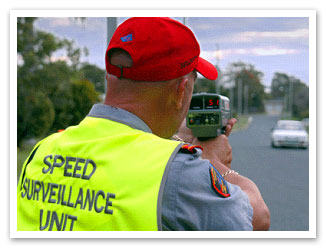What State Has The Most Tickets?
If you've been driving for a while, chances are you've received a traffic ticket or two in your time.
Maybe it was for something minor, like a parking violation. Most traffic tickets, however, are given for driving at speeds unsafe for current conditions.
 Speeding
Speeding
How fast should I drive?
Generally speaking, you should drive with the flow of traffic. That means you should drive at the same speed as the main stream of traffic around you.
Driving much slower or faster than the traffic around you is dangerous. Keep in mind that there are minimum speed limit laws as well as maximum speed limit laws.
If you go slow enough to impede or block the movement of traffic, you could be issued a ticket.
There are certain times when you should drive below the speed limit. Drivers must slow down when approaching and crossing an intersection, going around a curve,
approaching the top of a hill, or traveling on a narrow and winding road. Adverse weather, traffic, and pedestrians may also require you to drive below the posted speed limit.
Keep track of your speed by looking at the speedometer frequently and keeping with the flow of traffic. When you drive a vehicle, it can be easy to lose focus of your speed if you’re not paying attention.
Why do you get a ticket if you speed?
Speed limits exist to keep us all safe. When we exceed the speed limit, we put ourselves and others at risk of collisions, and can result in a traffic ticket. Why is it dangerous to drive too fast?
Well, speed reduces your field of vision. At a standstill, your field of vision may reach 180 degrees wide, giving you a clear view of all of the objects within a 180-degree angle of the front of your car.
The stationary car has a wide view. Any amount of speed will lessen your field of vision.
When you drive at 20 miles per hour, your field of vision will reduce to approximately two-thirds. At 40 miles per hour, your field of vision is decreased to two-fifths of what it was at no speed.
Finally, at 60 miles per hour, your field of vision is only 40 degrees.
This is why highway signs are posted above the roadway whenever possible. Road departments understand that drivers traveling at highway speeds can't always clearly read signs that are posted to the left or right.
Concentration also affects your field of vision. If you are focused only on one item ahead of your car, your field of vision becomes almost zero. You can’t see anything clearly other than the object you're
staring at. Many new drivers tend to stare at what they believe to be important: a roadway sign, the car in front of them, or the lines on the road. This can be dangerous, because it makes you
unable to see what’s going on around your vehicle. Always scan the road, and take in as much as possible with your eyes while driving.
Remember that speed affects your field of vision. Keep your speed at a safe level so you can see clearly and respond quickly to hazards that come from around you.
Which state has the most traffic tickets?
In 2021, Ohio had the highest percentage of drivers with a speeding ticket on record at 16.12%. The runner-up was Virginia with 15.76%.
What should I do if I get a traffic ticket?
If you've received a traffic ticket, we can help you figure out the next steps! Click here to find a detailed guide on how to handle a traffic ticket in every state.
Take an Online Course to Learn More
If you enjoyed this article and are interested in learning more about driving-related topics, you should check out our courses on www.safe2drive.com.
We offer courses in a variety of topics including Defensive Driving and Driver Education.
In addition to teaching you how to be a safe driver, our courses can help you dismiss a ticket, get your driver license,
or even get an insurance discount. We also have courses specifically tailored to mature drivers (i.e., drivers age 55 and older) for
insurance discounts.